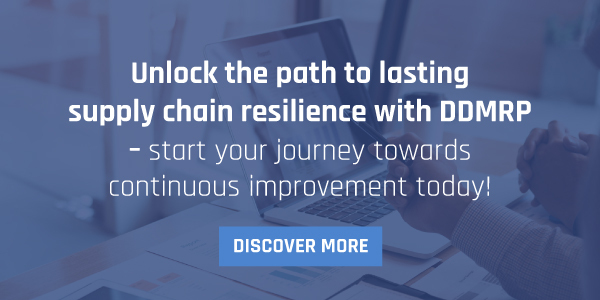
Improving Supply Chain Collaboration through DDMRP Implementation
September 6, 2024
Best Practices for Using DDMRP to Enhance Cross-Functional Team Collaboration
September 20, 2024Effective communication between suppliers and customers is critical for any business aiming to maintain an efficient and reliable supply chain. The complexities of modern supply chains, coupled with increasing customer demands, require companies to adopt innovative approaches to ensure seamless collaboration. One such innovation is Demand-Driven Material Requirements Planning (DDMRP), which offers a structured way of improving communication by aligning demand and supply in real-time. This article delves into how DDMRP plays a crucial role in streamlining supplier and customer communication, exploring its key components, benefits, challenges, and future prospects.
Introduction to DDMRP and Its Relevance in Supply Chain Management
DDMRP is a methodology designed to address the challenges posed by traditional Material Requirements Planning (MRP) systems. Traditional MRP systems often rely heavily on forecasted demand, which can lead to inefficiencies when actual demand differs from projections. These inefficiencies result in either excess inventory or stock shortages, both of which can disrupt the flow of goods in the supply chain.
In contrast, DDMRP focuses on real-time demand signals rather than historical forecasts, enabling companies to adapt more quickly to changes in customer demand. This shift in approach is essential in today’s dynamic market environment, where flexibility and responsiveness are key to maintaining competitive advantage. DDMRP achieves this by using strategically placed buffers that absorb variability in supply and demand, making it easier for companies to maintain optimal stock levels.
From a communication standpoint, DDMRP simplifies the exchange of information between suppliers and customers by aligning both parties around real-time data and common goals. This alignment ensures that everyone in the supply chain has access to accurate information, leading to more efficient collaboration and reduced miscommunication.
Key Components of DDMRP: A Foundation for Improved Communication
DDMRP is built on six core components, each of which plays a role in improving communication between suppliers and customers. Understanding these components is critical to grasping how DDMRP works and why it is so effective in fostering better collaboration.
- Strategic Inventory Positioning: Strategic inventory positioning involves placing stock at critical points in the supply chain to decouple lead times and absorb variability. This positioning reduces the need for constant communication about lead times and stock levels, as the buffers ensure that supply can meet demand even when there are disruptions. Suppliers and customers benefit from this increased predictability, as they can rely on the system to adjust automatically to changes in demand.
- Buffer Profiles and Levels: Buffers in DDMRP are not static; they are dynamic and change based on actual demand. Buffer profiles are used to determine the size of these buffers, taking into account factors like lead time and variability. The flexibility of buffer profiles ensures that inventory is adjusted in real time, preventing overstocking or stockouts. This adaptive approach enhances communication by reducing the need for constant back-and-forth between suppliers and customers regarding inventory levels.
- Dynamic Adjustments: Dynamic adjustments enable the supply chain to respond to fluctuations in demand without the need for complex communication between suppliers and customers. For example, if customer demand spikes unexpectedly, the buffer levels automatically adjust, ensuring that suppliers do not need to scramble to meet this sudden demand. This reduces the stress on communication systems, as much of the adjustment is handled by the DDMRP framework.
- Demand-Driven Planning: Demand-driven planning shifts the focus from forecast-driven planning to actual customer demand. This real-time approach ensures that suppliers and customers are always working with the most accurate data. By focusing on actual demand, companies can communicate more effectively and ensure that everyone in the supply chain is working toward the same goals.
- Visible and Collaborative Execution: This principle emphasises the importance of visibility across the supply chain. Suppliers and customers have access to the same real-time data, which fosters collaboration and reduces the likelihood of misunderstandings. This transparency allows for more informed decision-making, as both parties can see the same demand signals and act accordingly.
- Tactical Adaptation: It refers to the ongoing process of adjusting and refining the system based on real-world performance and future plans. It focuses on adapting the DDMRP model, which is established by the core components collectively known as the Master Settings. This adaptive process is guided by both historical performance data and projected future activities, a practice known as Demand Driven Sales and Operations Planning (DDS&OP).
How DDMRP Enhances Supplier and Customer Collaboration
DDMRP has a profound impact on the relationship between suppliers and customers by fostering collaboration through enhanced visibility, transparency, and data sharing. Traditional supply chains often suffer from a lack of alignment between suppliers and customers, with each party operating based on different information and forecasts. This misalignment can lead to delays, stockouts, or overproduction, all of which disrupt the supply chain.
By leveraging real-time demand data, DDMRP enables suppliers and customers to work together more effectively. Instead of relying on outdated forecasts or guesswork, both parties can respond to actual demand patterns, ensuring that the right products are available when needed. This creates a more agile supply chain, capable of responding to sudden changes in demand without the need for constant communication or firefighting.
Furthermore, the use of buffers in DDMRP reduces the frequency of urgent communications between suppliers and customers. With buffers absorbing fluctuations in demand, suppliers are less likely to face unexpected stockouts, and customers are less likely to experience delays in receiving products. As a result, communication between the two parties becomes more focused on strategic planning and less on crisis management.
Real-Time Visibility and Decision-Making: Strengthening Supplier and Customer Alignment
One of the most significant advantages of DDMRP is the real-time visibility it provides into the supply chain. Traditional supply chain systems often suffer from a lack of visibility, making it difficult for suppliers and customers to make informed decisions. With DDMRP, both suppliers and customers have access to real-time data on inventory levels, demand, and buffer statuses, allowing them to make better decisions in real-time.
For suppliers, this visibility means they can see how their products are being consumed and adjust their production schedules accordingly. For customers, it means they can track the status of their orders and have a better understanding of when they can expect delivery. This transparency strengthens the relationship between suppliers and customers by aligning their expectations and reducing the risk of miscommunication.
In addition to improving decision-making, real-time visibility also enhances trust between suppliers and customers. When both parties have access to the same data, there is less room for misunderstandings or disagreements. This fosters a more collaborative environment, where suppliers and customers can work together to address issues and optimise the supply chain.

Improving Responsiveness and Flexibility with DDMRP
In today’s fast-paced business environment, responsiveness and flexibility are critical to maintaining a competitive edge. Traditional supply chain systems, with their reliance on forecast-driven planning, often struggle to keep up with changes in demand. DDMRP addresses this challenge by providing a more flexible approach to planning and execution.
By focusing on actual demand rather than forecasts, DDMRP enables suppliers and customers to respond more quickly to changes in the market. This increased responsiveness is particularly valuable in industries with volatile demand patterns, such as retail or consumer goods. When demand spikes unexpectedly, the buffer system in DDMRP ensures that suppliers can meet this increased demand without the need for extensive communication or last-minute adjustments.
The flexibility of DDMRP also extends to its ability to adapt to changes in supply. For example, if a supplier experiences a delay in receiving raw materials, the buffer system can absorb this disruption, ensuring that customers do not experience delays in receiving finished products. This adaptability reduces the need for constant communication between suppliers and customers, as the system automatically adjusts to changes in supply and demand.
Managing Expectations and Reducing Supply Chain Disruptions
Misaligned expectations between suppliers and customers are a common cause of supply chain disruptions. When suppliers expect one level of demand and customers expect another, the result is often stockouts or excess inventory. DDMRP helps manage expectations by providing both parties with accurate, real-time data on demand and supply.
With DDMRP, suppliers and customers can set more realistic expectations for lead times, inventory levels, and delivery schedules. This alignment ensures that both parties are on the same page, reducing the risk of misunderstandings or unmet expectations. In addition, the buffer system in DDMRP acts as a safety net, absorbing variability in demand and supply and preventing disruptions from escalating into major issues.
DDMRP also reduces the need for last-minute communication to resolve issues. Because the system is designed to handle variability, suppliers and customers are less likely to encounter unexpected problems that require urgent intervention. This leads to a more stable and predictable supply chain, where both parties can focus on long-term planning rather than constantly reacting to short-term disruptions.

Overcoming Common Challenges in DDMRP Implementation
While DDMRP offers many benefits, its implementation can also present challenges. One common hurdle is the need for a cultural shift within the organisation. DDMRP requires a departure from traditional, forecast-driven planning models, which can be difficult for some companies to embrace. Overcoming this challenge requires strong leadership and a commitment to change management.
Another challenge is the need for accurate data. DDMRP relies on real-time data to function effectively and inaccurate or incomplete data can undermine its benefits. Companies must ensure that they have the necessary systems and processes in place to collect, analyse, and distribute accurate data across the supply chain. This may require investment in technology infrastructure, such as Enterprise Resource Planning (ERP) systems, or upgrades to existing systems to ensure seamless data integration.
Training is also a critical factor in overcoming DDMRP implementation challenges. Employees across the organisation—especially in supply chain management, procurement, and customer service—need to understand the principles of DDMRP and how it differs from traditional planning systems. Comprehensive training programs are essential to equip staff with the skills they need to use DDMRP effectively and to ensure that the benefits of the system are fully realised.
Resistance to change is another obstacle that companies may face when adopting DDMRP. Employees who are accustomed to traditional planning methods may be reluctant to embrace a new approach. To mitigate this resistance, companies should focus on clear communication about the benefits of DDMRP and how it will improve day-to-day operations. Involving employees in the implementation process, gathering their feedback, and addressing their concerns can help smooth the transition.
Finally, DDMRP implementation can require a shift in how companies manage their supplier and customer relationships. The success of DDMRP relies on collaboration and transparency, and suppliers and customers may need to adopt new ways of working together. Establishing clear communication channels and fostering a culture of trust and collaboration is crucial for overcoming this challenge.
The Future of DDMRP in Supplier and Customer Relationships
As supply chains become increasingly complex and customer demands continue to evolve, the role of DDMRP in streamlining supplier and customer communication is expected to grow. The flexibility and responsiveness offered by DDMRP make it well-suited to the challenges of modern supply chains, particularly in industries where demand can be unpredictable or highly variable.
One trend that is likely to shape the future of DDMRP is the increasing use of digital technologies in supply chain management. Technologies like the Internet of Things (IoT), artificial intelligence (AI), and advanced data analytics can enhance the capabilities of DDMRP by providing even more accurate and real-time demand signals. IoT devices, for instance, can provide real-time data on product usage, allowing companies to adjust buffer levels dynamically and with greater precision. AI-driven analytics can also help companies predict demand more accurately, enhancing the effectiveness of demand-driven planning.
Moreover, as supply chains continue to globalise, the need for improved communication between suppliers and customers will only become more critical. DDMRP’s ability to provide visibility and transparency across the entire supply chain will be an invaluable asset in this context. Companies that adopt DDMRP will be better equipped to navigate the complexities of global supply chains, respond to changing market conditions, and maintain strong relationships with their suppliers and customers.
Additionally, the growing focus on sustainability in supply chain management may drive further adoption of DDMRP. By optimising inventory levels and reducing waste, DDMRP can help companies achieve their sustainability goals while also improving supply chain efficiency. In the future, we may see more companies using DDMRP to strike a balance between profitability and sustainability, ensuring that their supply chains are both resilient and environmentally responsible.

Conclusion
DDMRP plays a transformative role in streamlining communication between suppliers and customers by fostering real-time data sharing, enhancing collaboration, and improving responsiveness. Its key components, such as strategic inventory positioning and dynamic adjustments, enable supply chains to adapt efficiently to fluctuations in demand and supply. By reducing miscommunication and aligning expectations, DDMRP strengthens supplier-customer relationships, leading to a more agile, resilient, and efficient supply chain. As businesses continue to evolve, DDMRP will remain a crucial tool in ensuring long-term supply chain success and competitiveness.
Learn how DDMRP can streamline communication with suppliers and customers.





